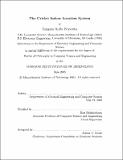The Cricket indoor location system
Author(s)
Priyantha, Nissanka Bodhi, 1968-
DownloadFull printable version (18.62Mb)
Other Contributors
Massachusetts Institute of Technology. Dept. of Electrical Engineering and Computer Science.
Advisor
Hari Balakrishnan.
Terms of use
Metadata
Show full item recordAbstract
Indoor environments present opportunities for a rich set of location-aware applications such as navigation tools for humans and robots, interactive virtual games, resource discovery, asset tracking, location-aware sensor networking etc. Typical indoor applications require better accuracy than what current outdoor location systems provide. Outdoor location technologies such as GPS have poor indoor performance because of the harsh nature of indoor environments. Further, typical indoor applications require different types of location information such as physical space, position and orientation. This dissertation describes the design and implementation of the Cricket indoor location system that provides accurate location in the form of user space, position and orientation to mobile and sensor network applications. Cricket consists of location beacons that are attached to the ceiling of a building, and receivers, called listeners, attached to devices that need location. Each beacon periodically transmits its location information in an RF message. At the same time, the beacon also transmits an ultrasonic pulse. The listeners listen to beacon transmissions and measure distances to nearby beacons, and use these distances to compute their own locations. (cont.) This active-beacon passive-listener architecture is scalable with respect to the number of users, and enables applications that preserve user privacy. This dissertation describes how Cricket achieves accurate distance measurements between beacons and listeners. Once the beacons are deployed, the MAT and AFL algorithms, described in this dissertation, use measurements taken at a mobile listener to configure the beacons with a coordinate assignment that reflects the beacon layout. This dissertation presents beacon interference avoidance and detection algorithms, as well as outlier rejection algorithms to prevent and filter out outlier distance estimates caused by uncoordinated beacon transmissions. The Cricket listeners can measure distances with an accuracy of 5 cm. The listeners can detect boundaries with an accuracy of 1 cm. Cricket has a position estimation accuracy of 10 cm and an orientation accuracy of 3 degrees.
Description
Thesis (Ph. D.)--Massachusetts Institute of Technology, Dept. of Electrical Engineering and Computer Science, 2005. Includes bibliographical references (p. 191-199).
Date issued
2005Department
Massachusetts Institute of Technology. Department of Electrical Engineering and Computer SciencePublisher
Massachusetts Institute of Technology
Keywords
Electrical Engineering and Computer Science.